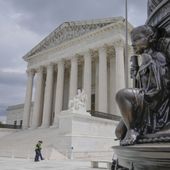The House voted yesterday to give a new look to the Sacajawea dollar in hopes of reviving flagging interest in the seven-year-old golden coin.
The legislation, approved by voice vote, would make annual changes to the reverse side of the coin to commemorate the achievements of other American Indian tribes. The image of Sacajawea, the young Shoshone who assisted Lewis and Clark on their expedition to the Pacific Northwest 200 years ago, would remain on the heads side of the coin.
The Sacajawea dollar was first minted in 2000 to replace the Susan B. Anthony dollar coin. Like its predecessor, it failed to catch on with most Americans.
The Sacajawea coin was originally intended for general circulation, but for the first five months of this year the U.S. Mint had produced only 7.5 million, all for collectors. In contrast, the Mint this year has produced 500 million of the new presidential $1 coins that came out in February.
Rep. Dale E. Kildee, Michigan Democrat and sponsor of the legislation, said the static design of the Sacajawea coin is one reason it is not as popular as the presidential coins. The design of those coins changes every three months, with the first, depicting Washington, to be succeeded by presidents in the order of their service. The John Adams coin was released May 17.
Rep. Michael N. Castle, Delaware Republican, said the new coin has the potential to save the Treasury $150 million a year if demand increases and the surplus of unused coins is eliminated.
The bill, if approved by the Senate and signed by the president, would require that the Sacajawea coin make up 20 percent of all $1 coins.
The designs would be decided by the secretary of Treasury in consultation with members of Congress, the National Congress of American Indians, the U.S. Commission of Fine Arts and the Citizens Coinage Advisory Committee.
The legislation suggested that potential designs could be the creation of the Cherokee written language, the Iroquois Confederacy, Wampanoag chief Massasoit or Olympian Jim Thorpe.
Currently, the reverse of the coin depicts a soaring eagle with 17 stars representing the states at the time of the 1804 Lewis and Clark expedition.



Please read our comment policy before commenting.